 Shrubs and trees are versatile and can be an important part of the garden. They can provide structure, define beds, serve as a backdrop or focal point, add color, create privacy, brighten fall coloration, lend winter interest, and attract wildlife. Shrubs and small trees can be used as hedges, windbreaks, foundation plantings, and specimen plants. No matter what you want for your garden there is probably a shrub or tree that can help you get it.
Shrubs and trees are versatile and can be an important part of the garden. They can provide structure, define beds, serve as a backdrop or focal point, add color, create privacy, brighten fall coloration, lend winter interest, and attract wildlife. Shrubs and small trees can be used as hedges, windbreaks, foundation plantings, and specimen plants. No matter what you want for your garden there is probably a shrub or tree that can help you get it.
Shurbs and trees are either evergreen and keep their color all year around, or are deciduous and drop their leaves that sometimes turn yellow, orange, red, or purple before falling. Some plants have purple, silver, or variegated leaves that provide color but even those that are all green vary in hue, intensity, and value. Just think of the difference between olive green, kelly green, yellow green, and blue green, or the difference between bright green and pale green. No matter what color, foliage also adds texture with some leaves being shinny, others matte or leathery, still others hairy or prickly. Texture also varies with the size of the leaves and its parts; just think of the difference between a fern frond and magnolia leaf.
When choosing trees and shrubs for the garden, their cultural requirements have to be considered. One of the most important of these requirements is the need for water. Plants greatly vary greatly in their need for water and using drought tolerant trees and shrub can significantly curb water consumption. Here is a list of drought tolerant shrubs and trees grown primarily for their foliage.
Wormwood (Artemisia absinthium)
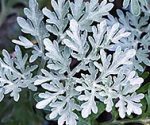 Also known as absinthe, this wood-based subshrub is native to Mediterranean Europe, temperate regions of Asia, and northern Africa where it grows in dry open areas, often on rocky slopes. The plants are upright, well branched, and have stems and foliage coated with silky hairs. The greenish-gray leaves are 1.5 to 4 inches long, strongly aromatic when bruised, and two to three times pinnately dissected above, less so below. The pale yellow flowerheads appear in summer in drooping panicles and are not ornamentally interesting. The plants are grown for the silvery foliage that brightens the colors of hot pink, red, and oranges flowers, while blending the colors of pastel pink, blue, and purple flowers.
Also known as absinthe, this wood-based subshrub is native to Mediterranean Europe, temperate regions of Asia, and northern Africa where it grows in dry open areas, often on rocky slopes. The plants are upright, well branched, and have stems and foliage coated with silky hairs. The greenish-gray leaves are 1.5 to 4 inches long, strongly aromatic when bruised, and two to three times pinnately dissected above, less so below. The pale yellow flowerheads appear in summer in drooping panicles and are not ornamentally interesting. The plants are grown for the silvery foliage that brightens the colors of hot pink, red, and oranges flowers, while blending the colors of pastel pink, blue, and purple flowers.
Type: Subshrub
Height: 2-3′
Light: Full sun
Hardiness: Zones 3-9
Sagebrush (Artemesia tridentata)
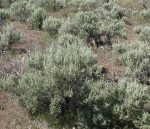 This evergreen shrub or small tree, also known as big sagebrush and Great Basin sagebrush, is native to the western US and Canada where it grows in arid and semi-arid conditions in cold desert, steppe, amd mountain habitats. Plants have a deep taproot with spreading roots near the surface of the soil and grow 3-15″ tall with a short trunk that become twisted with age. They are well branched and have highly aromatic, wedge-shaped, silvery-gray leaves that are covered with fine hairs and usually tipped with three lobes or teeth. In late summer or early fall, elongated clusters of small yellow flowerheads appear and give way to seed-like fruits. Sagebrush provides food and cover for a variety of wildlife including pronghorn antelope and sage grouse. It is extremely drought tolerant and can be used for erosion control, and as a hedge, screen or groundcover.
This evergreen shrub or small tree, also known as big sagebrush and Great Basin sagebrush, is native to the western US and Canada where it grows in arid and semi-arid conditions in cold desert, steppe, amd mountain habitats. Plants have a deep taproot with spreading roots near the surface of the soil and grow 3-15″ tall with a short trunk that become twisted with age. They are well branched and have highly aromatic, wedge-shaped, silvery-gray leaves that are covered with fine hairs and usually tipped with three lobes or teeth. In late summer or early fall, elongated clusters of small yellow flowerheads appear and give way to seed-like fruits. Sagebrush provides food and cover for a variety of wildlife including pronghorn antelope and sage grouse. It is extremely drought tolerant and can be used for erosion control, and as a hedge, screen or groundcover.
Type: Evergreen shrub or small tree
Height:3-15′
Light: Full sun
Hardiness: Zones 4-10
Photo Credit:Wikimedia
Four-Wing Saltbush (Atriplex canescens)
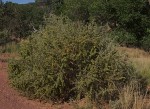 Also called shadscale, this evergreen shrub is native to western and midwestern US, from the Dakotas south to Texas and west to the coast. It is a member of the goosefoot family, Amaranthaceae, that also includes beet, celosia, and Russian thistle. The specieas is highly variable and plants can grow from 1-10″ tall although 3-6′ is most common. The dense branches and small spoon-shaped, grayish leaves up to 2″ long are covered with dense silvery soft hairs. In the summer, spike-like panciles of male or female, yellow-green flowers lacking showy petals appear on different plants. The gender of the plant is not genetically fixed and any given plant can change gender in response to environmental cues. Fertilized female flowers give way to unique large fruits that have four densely packed wings roughtly situated at 90 degree angles and the stems bearing fruits resemble a mass of corn flakes. Plants are fire resistant, very drought tolerant, and are able to grow in saline soil. They are an excellent choice for xeriscapes, seaside, and desert gardens where they can be used as hedges, erosion control, and food for wildlife but can be invasive in wetlands.
Also called shadscale, this evergreen shrub is native to western and midwestern US, from the Dakotas south to Texas and west to the coast. It is a member of the goosefoot family, Amaranthaceae, that also includes beet, celosia, and Russian thistle. The specieas is highly variable and plants can grow from 1-10″ tall although 3-6′ is most common. The dense branches and small spoon-shaped, grayish leaves up to 2″ long are covered with dense silvery soft hairs. In the summer, spike-like panciles of male or female, yellow-green flowers lacking showy petals appear on different plants. The gender of the plant is not genetically fixed and any given plant can change gender in response to environmental cues. Fertilized female flowers give way to unique large fruits that have four densely packed wings roughtly situated at 90 degree angles and the stems bearing fruits resemble a mass of corn flakes. Plants are fire resistant, very drought tolerant, and are able to grow in saline soil. They are an excellent choice for xeriscapes, seaside, and desert gardens where they can be used as hedges, erosion control, and food for wildlife but can be invasive in wetlands.
Type: Evergreen shrub
Height: 1-1-‘ but 3-6’ more common
Light: Full sun
Hardiness: Zones 4-10
Bottle Tree (Brachychiton populneus)
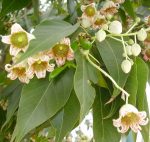 Commonly known as the kurrajong, this small to medium-sized evergreen tree is native to Australia where it grows in diverse habitats. The trees grow 30-50′ tall and have a bottle like swelling at the base of their trunks which stores water. The ovate green leaves are up to 3″ long, may be simple or have 3-9 lobes, and shimmer in the breeze like those of quaking aspens. In late spring or early summer 3″ long clusters of male and female 1/2″ wide yellowish-white flowers appear on the same plant. They lack petals but the caylx forms bell shaped perianth that is reddish inside and sometimes has dark spots on the outside. Fertilized female flowers give way to a woody canoe-shaped dry seedpod that is 2-3″ long and can be a litter problem. Bottle tree is tolerant of drought and partial shade, and is suitable for windbreaks, screen, street tree, and shade tree in a xeriscape. The seedpods are attractive in dried arrangements.
Commonly known as the kurrajong, this small to medium-sized evergreen tree is native to Australia where it grows in diverse habitats. The trees grow 30-50′ tall and have a bottle like swelling at the base of their trunks which stores water. The ovate green leaves are up to 3″ long, may be simple or have 3-9 lobes, and shimmer in the breeze like those of quaking aspens. In late spring or early summer 3″ long clusters of male and female 1/2″ wide yellowish-white flowers appear on the same plant. They lack petals but the caylx forms bell shaped perianth that is reddish inside and sometimes has dark spots on the outside. Fertilized female flowers give way to a woody canoe-shaped dry seedpod that is 2-3″ long and can be a litter problem. Bottle tree is tolerant of drought and partial shade, and is suitable for windbreaks, screen, street tree, and shade tree in a xeriscape. The seedpods are attractive in dried arrangements.
Type: Evergreen tree
Height: 30-50′
Light: Full sun; shade tolerant
Hardiness: Zones 8-11
Photo Credit:Wikipedia
Narrowleaf Mountain Mahogany (Cerocarpus intricatus)
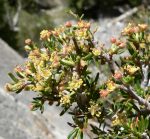 This evergreen shrub is native to western US from Wyoming south to Colorado and New Mexico, west to California. It grows 6-8′ tall and has an intricate branching structure and small, narrow, leathery leaves that are blue-green and up to 1/2″ long. The edges of the leaves roll under and sometimes roll under so much that the leaves appear tubular. In spring, inconspicuous, petaless flowers appear bearing a 5-lobed tube formed by the sepals. The long fruit is twisted and carries a long plume. The plants are very drought tolerant and suitable for a xeriscape where it can be used as a hedge or screen if pruned to produce dense growth.
This evergreen shrub is native to western US from Wyoming south to Colorado and New Mexico, west to California. It grows 6-8′ tall and has an intricate branching structure and small, narrow, leathery leaves that are blue-green and up to 1/2″ long. The edges of the leaves roll under and sometimes roll under so much that the leaves appear tubular. In spring, inconspicuous, petaless flowers appear bearing a 5-lobed tube formed by the sepals. The long fruit is twisted and carries a long plume. The plants are very drought tolerant and suitable for a xeriscape where it can be used as a hedge or screen if pruned to produce dense growth.
Type: Evergreen shrub
Height: 6-8′
Light: Full sun
Hardiness: Zones 4-9
Photo Credit: Wikimedia Commons
Curl-leaf Mountain Mahogany (Cerocarpus ledifolius)
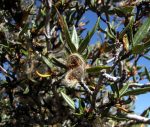 This evergreen shrub or small tree is native to dry mountain slopes of western US from Washington to California, east to Idaho, Montana, Wyoming, Colorado, Utah and northern Arizona. The densely branched plants can grow up to 35′ tall but are usually shorter and have a spreading open crown of thick twisted branches with reddish-brown bark. The leathery lanceolate leaves are up to 1.6″ long, sticky and sometimes have rolled-under margins. They are dark green on the top, white and hairy below and are often clustered at the ends of spur-like shoots. In spring, single or small clusters of 2-3 greenish yellow flowers appear. The flowers lack petals and consist of an elongated tube formed by the sepals. The trumpet-like tube opens into 5 lobes and contains a plume-like style covered with tan hairs. The fruit is hairy and has a twisted plume-like tail. The plants are extremely drought tolerant and when pruned back hard to encourage branching make an excellent screen or hedge, especially in a xeriscape.
This evergreen shrub or small tree is native to dry mountain slopes of western US from Washington to California, east to Idaho, Montana, Wyoming, Colorado, Utah and northern Arizona. The densely branched plants can grow up to 35′ tall but are usually shorter and have a spreading open crown of thick twisted branches with reddish-brown bark. The leathery lanceolate leaves are up to 1.6″ long, sticky and sometimes have rolled-under margins. They are dark green on the top, white and hairy below and are often clustered at the ends of spur-like shoots. In spring, single or small clusters of 2-3 greenish yellow flowers appear. The flowers lack petals and consist of an elongated tube formed by the sepals. The trumpet-like tube opens into 5 lobes and contains a plume-like style covered with tan hairs. The fruit is hairy and has a twisted plume-like tail. The plants are extremely drought tolerant and when pruned back hard to encourage branching make an excellent screen or hedge, especially in a xeriscape.
Type: Evergreen shrub or small tree
Height: 3-35′
Light: Full sun
Hardiness: Zones 3-8
Photo Credit: Wikimedia Commons
Mountain Mahogany (Cerocarpus montanus)
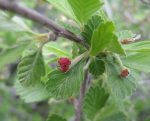 Also known as alder-leaf mountain-mahogany, alder-leaf cercocarpus, and true mountain-mahogany, this mostly deciduous long lived shrub or small tree grows in chaparral scrub, and on mesas and the lower foothills from Montana, Idaho, and South Dakota south to northern Mexico. It has open branching with mahogany red to brown stems that can be fissured or scaley, and can grow up to 20′ tall, but are usually 5-12′ tall due to wild life browsing. The leathery, lanceolate to obovate leaves range in length from 0.4 to 2″ and are prominently veined and may be coarsely toothed. They are green on the top, hairy white on the underside until fall when they turn russet. In early summer, insignificant flowers appear singly or in cluster of up to 12. The flowers lack petals but have yellowish white sepals and give way in the fall to fruit with a silky, silvery white plume that is 2-5″ long. A shrub covered with fruits and their plumes is especially attractive when backlit. Plants are very drought tolerant and if pruned hard to promote dense growth can be used as a hedge or screen.
Also known as alder-leaf mountain-mahogany, alder-leaf cercocarpus, and true mountain-mahogany, this mostly deciduous long lived shrub or small tree grows in chaparral scrub, and on mesas and the lower foothills from Montana, Idaho, and South Dakota south to northern Mexico. It has open branching with mahogany red to brown stems that can be fissured or scaley, and can grow up to 20′ tall, but are usually 5-12′ tall due to wild life browsing. The leathery, lanceolate to obovate leaves range in length from 0.4 to 2″ and are prominently veined and may be coarsely toothed. They are green on the top, hairy white on the underside until fall when they turn russet. In early summer, insignificant flowers appear singly or in cluster of up to 12. The flowers lack petals but have yellowish white sepals and give way in the fall to fruit with a silky, silvery white plume that is 2-5″ long. A shrub covered with fruits and their plumes is especially attractive when backlit. Plants are very drought tolerant and if pruned hard to promote dense growth can be used as a hedge or screen.
Type: Deciduous shrub
Height: 5-20′
Light: Full sun
Hardiness: Zones 5-10
Photo Credit: Nadiatalent-Wikipedia
Thorny Eleagnus (Eleagnus pungens) ‘Variegata’
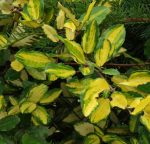 This vine-like sprawling evergreen shrub also known as thorny olive, spiny oleaster, and silverthorn, is native to China and Japan. It grows 12-15′ tall by 15-18′ wide and is densely branched with stems that are covered with brown scales and usually have spines 2-3″ long. The elliptical to oblong leaves are 2-4″ long, have wavy margins, and are variegated green with white or yellow above and covered with silvery scales below. Both the the main veins and petiole are covered with brown scales. In the fall, axillary clusters of 2-3 very fragrant, silvery white flowers appear. The inconspicuous flowers are 1/4″ long, lack petals, and are bell-shaped. The one-seeded fleshy fruits are 1/2″ across, reddish brown when they ripen in the spring, and are attractive to birds. Many cultivars are available. Thorny eleagnus is tolerant of heat, drought, salt and pollution so can be used in xeriscapes, urban plantings, and seaside gardens. It can be sheared into a formal hedge and can be used as a screen, windbreak, or for erosion control as well as for bonsai.
This vine-like sprawling evergreen shrub also known as thorny olive, spiny oleaster, and silverthorn, is native to China and Japan. It grows 12-15′ tall by 15-18′ wide and is densely branched with stems that are covered with brown scales and usually have spines 2-3″ long. The elliptical to oblong leaves are 2-4″ long, have wavy margins, and are variegated green with white or yellow above and covered with silvery scales below. Both the the main veins and petiole are covered with brown scales. In the fall, axillary clusters of 2-3 very fragrant, silvery white flowers appear. The inconspicuous flowers are 1/4″ long, lack petals, and are bell-shaped. The one-seeded fleshy fruits are 1/2″ across, reddish brown when they ripen in the spring, and are attractive to birds. Many cultivars are available. Thorny eleagnus is tolerant of heat, drought, salt and pollution so can be used in xeriscapes, urban plantings, and seaside gardens. It can be sheared into a formal hedge and can be used as a screen, windbreak, or for erosion control as well as for bonsai.
Type: Evergreen shrub
Height: 12-15′
Light: Full sun to partial shade
Hardiness: Zones 7-9
Mormon Tea (Ephedra viridis)
 Also known as Indian tea and green ephedra, this evergreen coniferous shrub is native to western US from the Arizona deserts to California, east of the Sierra Nevada, San Joaquin Valley and southern mountains, and to Utah, the western edge of the Colorado desert into southwestern Wyoming. It grows in varied scrub woodland, desert, and open habitats at elevations bewtween 3,000 and 7,500ft. Plants grow 3- 4′ tall and have dense clusters of thin green evergreen stems aging to yellow and bearing tiny pairs of insignificant awl-shaped leaves at the nodes. In spring, clusters of 2-5 male and 2-6 female flowers are produced at the nodes of different plants. Male pollen cones are smaller than the female seed cones. The plants are considered effective all year round and are valued in desert gardens and xeriscapes.
Also known as Indian tea and green ephedra, this evergreen coniferous shrub is native to western US from the Arizona deserts to California, east of the Sierra Nevada, San Joaquin Valley and southern mountains, and to Utah, the western edge of the Colorado desert into southwestern Wyoming. It grows in varied scrub woodland, desert, and open habitats at elevations bewtween 3,000 and 7,500ft. Plants grow 3- 4′ tall and have dense clusters of thin green evergreen stems aging to yellow and bearing tiny pairs of insignificant awl-shaped leaves at the nodes. In spring, clusters of 2-5 male and 2-6 female flowers are produced at the nodes of different plants. Male pollen cones are smaller than the female seed cones. The plants are considered effective all year round and are valued in desert gardens and xeriscapes.
Type: Evergreen coniferous shrub
Height: 3-4′
Light: Full sun
Hardiness: Zones 5-10
Photo Credit: Wikipedia
Silver Dollar Tree (Eucalyptus polyanthemos)
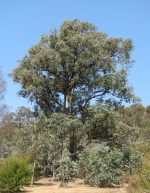 Also called Australian beech and red box, this small to medium evergreen tree is native to southeastern Australia. It grows up to 75′ tall and has fibrous mottled bark and fragrant gray-green leaves that are up to 3″ long and are round or oval when young but lance-shape and up to 4.3″ long when mature. In spring to summer, clusters of 7 off-white flowers appear at the ends of branchlets but are not ornamentally significant. They give way to woody, barrel-shapped to conical fruit capsules that are about 1/4″ long. The trees are popular street trees and shade trees, and used as windbreaks. The young leaves are often used in dried arrangements.
Also called Australian beech and red box, this small to medium evergreen tree is native to southeastern Australia. It grows up to 75′ tall and has fibrous mottled bark and fragrant gray-green leaves that are up to 3″ long and are round or oval when young but lance-shape and up to 4.3″ long when mature. In spring to summer, clusters of 7 off-white flowers appear at the ends of branchlets but are not ornamentally significant. They give way to woody, barrel-shapped to conical fruit capsules that are about 1/4″ long. The trees are popular street trees and shade trees, and used as windbreaks. The young leaves are often used in dried arrangements.
Type: Evergreen tree
Height: 30-75′
Light: Full sun
Hardiness: Zones 9-10
Photo Credit: Wikipedia
Apache Plume (Fallugia paradoxa)
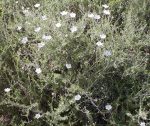 This twiggy, deciduous to semi-evergreen shrub is native to western US from southern California east to Arizona, New Mexico, and Texas where it grows in semidesert foothills, canyons, and arroyos. Growing 3-8′ tall the plant has many thin branches with whitish stems and exfoliating bark. The dark green, hairy, pinnate leaves have silvery undersides and 3-7 lobes. They are up to 1/2″ long and have margins that roll under. In late spring and early summer solitary, white, 5-petaled flowers appear that are up to 2″ across and attractive to bees and butterflies. The flowers are followed by seed capsules with feathery lavender plumes up to 2″ long. Plants are heat and drought tolerant, a good source of forage for wildlife, effective for erosion control and a good choice for a border, native plant or wildlife garden especially in a xeriscape.
This twiggy, deciduous to semi-evergreen shrub is native to western US from southern California east to Arizona, New Mexico, and Texas where it grows in semidesert foothills, canyons, and arroyos. Growing 3-8′ tall the plant has many thin branches with whitish stems and exfoliating bark. The dark green, hairy, pinnate leaves have silvery undersides and 3-7 lobes. They are up to 1/2″ long and have margins that roll under. In late spring and early summer solitary, white, 5-petaled flowers appear that are up to 2″ across and attractive to bees and butterflies. The flowers are followed by seed capsules with feathery lavender plumes up to 2″ long. Plants are heat and drought tolerant, a good source of forage for wildlife, effective for erosion control and a good choice for a border, native plant or wildlife garden especially in a xeriscape.
Type: Deciduous or semievergreen shrub
Height: 3-8′
Light: Full sun to partial shade
Hardiness: Zones 5-10
Photo Credit: Stan-Shebs,Wikimedia Commons
Desert Olive (Forestiera neomexicana aka F. pubescens var. pubescens)
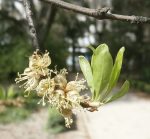 Also known as stretchberry, elbowbush, spring goldengrow, Texas forsythia, and downy forestier, this thicket-forming deciduous shrub or small tree is native to desert slopes, canyons, woodland edges and openings, pastures, meadows, prairies, and flats from Colorado and Utah south to Texas and California. Arched branches with smooth chalky gray bark have spiny branchlets and light-green oval leathery leaves that turn yellow in fall. Small inconspicuous male and female flowers appear in clusters on different plants from late winter to spring before the leaves appear. They are greenish yellow, lack petals, and are fragrant. Female flowers give way to clusters of tiny blue-black fruits that are attractive to birds and mammals. Plants are host to hairstreak larva, while the flowers attract butterflies, bees, and other insects. Desert olive is adaptable and tolerates dry or moist soil as well as sun or shade. It is a good choice for a specimen, patio tree, or a natural or wildlife garden. It can also be trimmed into a hedge or used as a groundcover.
Also known as stretchberry, elbowbush, spring goldengrow, Texas forsythia, and downy forestier, this thicket-forming deciduous shrub or small tree is native to desert slopes, canyons, woodland edges and openings, pastures, meadows, prairies, and flats from Colorado and Utah south to Texas and California. Arched branches with smooth chalky gray bark have spiny branchlets and light-green oval leathery leaves that turn yellow in fall. Small inconspicuous male and female flowers appear in clusters on different plants from late winter to spring before the leaves appear. They are greenish yellow, lack petals, and are fragrant. Female flowers give way to clusters of tiny blue-black fruits that are attractive to birds and mammals. Plants are host to hairstreak larva, while the flowers attract butterflies, bees, and other insects. Desert olive is adaptable and tolerates dry or moist soil as well as sun or shade. It is a good choice for a specimen, patio tree, or a natural or wildlife garden. It can also be trimmed into a hedge or used as a groundcover.
Type: Deciduous small tree or shrub
Height: 8′
Light: Full sun to part shade
Hardiness: Zones 4-9
Photo Credit: Miguel Angel Sepulveda, Wikimedia Commons
Kentucky Coffee Tree (Gymnocladus dioica)
 This tall deciduous tree earned its common name from the fact that early American settlers made a beverage from its roasted and ground seeds. Unroasted pods and seeds, however, are toxic. Kentucky Coffee tree is native to the rich moist woods of eastern and Midwestern United States but is planted across the country as an urban shade tree because of its tolerance to drought and pollution as well as its ability to adapt to a large range of soil condiditons. Leaves appear in late spring with a touch of pink and gradually turn blue-green in summer, then variable yellow in fall. Each bi-pinnately compound leaf is up to three feet long and two feet wide, bearing up to one hundred small leaflets. In mid to late spring, male trees bear flowers in panicles three to four inches long while female trees bear clusters of greenish white flowers in panicles eight to twelve inces long. The flowers on the female trees give way to brownish black seed pods that are five to ten inches long and contain several large seeds. The seedpods and large leaves can be considered a liability and male trees are preferred to female to reduce the litter. In spite of the litter problem, Kentucky Coffee tree is a handsome plant and desirable for a lawn and shade tree. It is especially attractive in winter when its branching habit creates a bold silhouette and its rough furrowed bark can be appreciated.
This tall deciduous tree earned its common name from the fact that early American settlers made a beverage from its roasted and ground seeds. Unroasted pods and seeds, however, are toxic. Kentucky Coffee tree is native to the rich moist woods of eastern and Midwestern United States but is planted across the country as an urban shade tree because of its tolerance to drought and pollution as well as its ability to adapt to a large range of soil condiditons. Leaves appear in late spring with a touch of pink and gradually turn blue-green in summer, then variable yellow in fall. Each bi-pinnately compound leaf is up to three feet long and two feet wide, bearing up to one hundred small leaflets. In mid to late spring, male trees bear flowers in panicles three to four inches long while female trees bear clusters of greenish white flowers in panicles eight to twelve inces long. The flowers on the female trees give way to brownish black seed pods that are five to ten inches long and contain several large seeds. The seedpods and large leaves can be considered a liability and male trees are preferred to female to reduce the litter. In spite of the litter problem, Kentucky Coffee tree is a handsome plant and desirable for a lawn and shade tree. It is especially attractive in winter when its branching habit creates a bold silhouette and its rough furrowed bark can be appreciated.
Type: Deciduous tree
Height: 60-80′
Light: Full sun
Hardiness: Zones 3-8
Yaupon Holly (Ilex vomatoria)
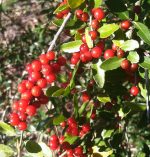 This thicket-formng evergreen shrub or small tree is native to sandy woods, dunes, open fields, forest edges, and wet swamps especially in the coastal plain and maritime forests from Virginia to Florida, Arkansas, and Texas. Plants grow 10-20′ tall and have glossy, dark green, eliptical to oblong leaves up to 1.5″ long and with wavy toothed margins. In spring, fragrant, inconspicuous greenish-white male and female flowers appear on different plants and are attractive to butterflies.. The female flowers give way to red berry-like fruits about 1/4″ across that persist into winter and are attractive to birds. Plants can take hard pruning so are good subjects for topiary and edging of parterres. They form good hedges, screens and windbreaks and can be used in wildlife, butterfuly, and native plant gardens. Many cultivars are availble that vary most signficantly in size.
This thicket-formng evergreen shrub or small tree is native to sandy woods, dunes, open fields, forest edges, and wet swamps especially in the coastal plain and maritime forests from Virginia to Florida, Arkansas, and Texas. Plants grow 10-20′ tall and have glossy, dark green, eliptical to oblong leaves up to 1.5″ long and with wavy toothed margins. In spring, fragrant, inconspicuous greenish-white male and female flowers appear on different plants and are attractive to butterflies.. The female flowers give way to red berry-like fruits about 1/4″ across that persist into winter and are attractive to birds. Plants can take hard pruning so are good subjects for topiary and edging of parterres. They form good hedges, screens and windbreaks and can be used in wildlife, butterfuly, and native plant gardens. Many cultivars are availble that vary most signficantly in size.
Type: Evergreen shrub or small tree
Height: 1-20′
Light: Full sun to shade
Hardiness: Zones 7-9
Photo Credit:Wikimedia Commons
Cherrystone Juniper (Juniperus monosperma)
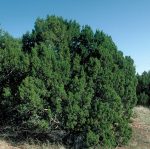 Also called one-seeded juniper, this evergreen coniferous shrub or small tree is native to the mountains of southwestern US in Arizona, New Mexico, southern Colorado, panhandle of Oklahoma, and western Texas where they grow on dry sandy or rocky slopes. Plants grow up to 50′ tall from a deep root system and are multistemmed, densely branched, and may be knarled. Stems have reddish brown to gray-brown bark that exfoliates in thin longitudinal strips to expose bright orange brown beneath. Young foliage is needle-like while mature leaves are scale-like. In spring male and female berry-like cones are produced on different plants. Female plants produce berry-like fruits that are black to copper-colored with waxy bloom, contain one seed and are eaten by birds and small mammals. Cherrystone juniper is extremly drought tolerant once esptablished and is an excellent choice for erosion control or a screen especially in a xeriscape.
Also called one-seeded juniper, this evergreen coniferous shrub or small tree is native to the mountains of southwestern US in Arizona, New Mexico, southern Colorado, panhandle of Oklahoma, and western Texas where they grow on dry sandy or rocky slopes. Plants grow up to 50′ tall from a deep root system and are multistemmed, densely branched, and may be knarled. Stems have reddish brown to gray-brown bark that exfoliates in thin longitudinal strips to expose bright orange brown beneath. Young foliage is needle-like while mature leaves are scale-like. In spring male and female berry-like cones are produced on different plants. Female plants produce berry-like fruits that are black to copper-colored with waxy bloom, contain one seed and are eaten by birds and small mammals. Cherrystone juniper is extremly drought tolerant once esptablished and is an excellent choice for erosion control or a screen especially in a xeriscape.
Type: Evergreen shrub or small tree
Height: Up to 50′
Light:Full sun
Hardiness: Zones 4-8
Photo Credit:Wikipedia
Rocky Mountain Juniper (Juniperus scopulorum)
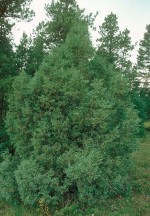 A native of dry, rocky ridges in the eastern foothills of the Rocky Mountains, this small evergreen broad pyramidal tree grows 30-40′ tall and has vertical growing branches and medium texture. The red- brown to gray bark is shredding and provides year round interest. The leaves are scale-like and either deep green or blue-green. Male and female cones are usually produced on different trees with the female cones giving rise to small deep blue berry-like fruits with a whitish bloom that take two year to ripen. Rocky Mountain juniper is a long lived tree, with remains in New Mexico suggesting they were 2,000 years old. In spite of its longevity, this tree in intolerant of wet soils and the heat and humidity of the Deep South. Although it is susceptible to juniper blights and is an alternative host to cedar apple-rust, it is a valuable garden plant and is popular as a specimen, hedge, screen, foundation planting, and in containers. The cultivar ‘Skyrocket’ is very popular because of its columnar upright growth but it is very susceptible to fungal disease and is being superseded by ‘Blue Arrow’ that has more disease resistance. Many cultivars are available offering variety in foliage color, size and shape.
A native of dry, rocky ridges in the eastern foothills of the Rocky Mountains, this small evergreen broad pyramidal tree grows 30-40′ tall and has vertical growing branches and medium texture. The red- brown to gray bark is shredding and provides year round interest. The leaves are scale-like and either deep green or blue-green. Male and female cones are usually produced on different trees with the female cones giving rise to small deep blue berry-like fruits with a whitish bloom that take two year to ripen. Rocky Mountain juniper is a long lived tree, with remains in New Mexico suggesting they were 2,000 years old. In spite of its longevity, this tree in intolerant of wet soils and the heat and humidity of the Deep South. Although it is susceptible to juniper blights and is an alternative host to cedar apple-rust, it is a valuable garden plant and is popular as a specimen, hedge, screen, foundation planting, and in containers. The cultivar ‘Skyrocket’ is very popular because of its columnar upright growth but it is very susceptible to fungal disease and is being superseded by ‘Blue Arrow’ that has more disease resistance. Many cultivars are available offering variety in foliage color, size and shape.
Type: Coniferous evergreen tree
Height: 30-40′
Light: Full sun
Hardiness: Zones 4-8
Photo Credit” Dave-Powell-USDA-Forest-Service
Eastern Redcedar (Juniperus virginiana)
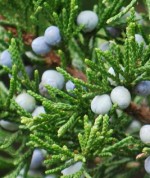 Eastern redcedar is an evergreen coniferous tree native to the woodland edges, old fields, meadows, and rocky ground of eastern North America from Nova Scotia and Ontario, south to Florida and Texas. The small to medium sized tree may be conical or oval to rounded and has reddish brown bark that is scented and exfoliates in thin ragged strips. The awl-like needles are olive to deep green, darkening or yellowing in winter. Male and female cones are produced on different trees. The female cones are blue-gray, berry-like and up to ¼ inch long while the male pollen cones are half that size. The seed cones are attractive to many birds. Eastern redcedar is a pioneer species and a tough plant that tolerates a wide variety of soil types, but not shade. It is a good choice for a hedge, windbreak, screen, and topiary but carries cedar apple rust so should not be planted near apple trees.
Eastern redcedar is an evergreen coniferous tree native to the woodland edges, old fields, meadows, and rocky ground of eastern North America from Nova Scotia and Ontario, south to Florida and Texas. The small to medium sized tree may be conical or oval to rounded and has reddish brown bark that is scented and exfoliates in thin ragged strips. The awl-like needles are olive to deep green, darkening or yellowing in winter. Male and female cones are produced on different trees. The female cones are blue-gray, berry-like and up to ¼ inch long while the male pollen cones are half that size. The seed cones are attractive to many birds. Eastern redcedar is a pioneer species and a tough plant that tolerates a wide variety of soil types, but not shade. It is a good choice for a hedge, windbreak, screen, and topiary but carries cedar apple rust so should not be planted near apple trees.
Type: Coniferous evergreen tree
Height: 25-60′
Light: Full sun
Hardiness: Zones 2-9
Northern Bayberry (Myrica pensylvanica)
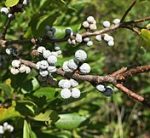 This upright, suckering shrub is a native of coastal North America and was important in colonial times when candles were made from the berries. Deciduous or semi-evergreen, depending on the climate, northern bayberry is irregular to mounded and has one to four inch long dark green aromatic leathery leaves that slowly turn bronze to tan in winter. Male and female flowers are produced on separate plants and one male should be planted for every five females to ensure good fruit set. Small wax covered gray-green berries are produced by female plants in the fall. Northern bayberry fixes its own nitrogen from the air so does well on infertile soil. It is effective for large-scale masses, shrub borders, and informal hedges, and can be used to stabilize soils because of its colonizing nature. It is tolerant of wind and salt so is an excellent plant for seaside plantings.
This upright, suckering shrub is a native of coastal North America and was important in colonial times when candles were made from the berries. Deciduous or semi-evergreen, depending on the climate, northern bayberry is irregular to mounded and has one to four inch long dark green aromatic leathery leaves that slowly turn bronze to tan in winter. Male and female flowers are produced on separate plants and one male should be planted for every five females to ensure good fruit set. Small wax covered gray-green berries are produced by female plants in the fall. Northern bayberry fixes its own nitrogen from the air so does well on infertile soil. It is effective for large-scale masses, shrub borders, and informal hedges, and can be used to stabilize soils because of its colonizing nature. It is tolerant of wind and salt so is an excellent plant for seaside plantings.
Type: Deciduous or semi-evergreen shrub
Height: 1-12′
Light: Full sun but tolerates some shade
Hardiness: Zones 2-7
Photo Credit:Wikipedia
Ponderosa Pine (Pinus ponderosa)
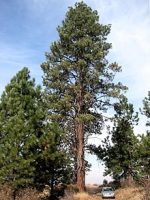 Ponderosa pine is a large confierous evergreen tree native to rocky cliffs and dry slopes in mountainous regions of western US from southwestern North Dakota, south the Texas and west to Washington, Oregon, and southern California. It is known by a variety of names including western yellow, bull, blackjack, big heavy, western red, western pitch, Sierra brownbark, ponderosa white, and western longleaf pine. Ponderosa pine is very variable and divided into 5 subspecies. The trees grow from a spreading root system with deep a tap root and can reach 230′ in their native habitat but are normally 60-100′ tall in cultivation. They have a straight main stem that is blackish-brown when the trees are young but develops yellow to orange-red bark in broad plates with deep irregular fissures when mature and is fire resistant. The bright-green needles are usually in bundles of 2-5, and vary in lenght from 2.7-10″ long depending on the subspecies. Pollen and seed cones are produced in the spring. The yellow to red pollen cones are cyllindrical and .6-1.4″ long. The seed cones are solitary (rarely in pairs) and mature in 2 years . They are reddish brown and conic to ovoid before opening to broadly ovoid and becoming 2-6″ long, and prickly. Ponderosa pine is tolerant of high elevation, a wide range of soils including alkaline, low humidity, wind, and drought when established. It is useful for windbreaks and bufferstrips.
Ponderosa pine is a large confierous evergreen tree native to rocky cliffs and dry slopes in mountainous regions of western US from southwestern North Dakota, south the Texas and west to Washington, Oregon, and southern California. It is known by a variety of names including western yellow, bull, blackjack, big heavy, western red, western pitch, Sierra brownbark, ponderosa white, and western longleaf pine. Ponderosa pine is very variable and divided into 5 subspecies. The trees grow from a spreading root system with deep a tap root and can reach 230′ in their native habitat but are normally 60-100′ tall in cultivation. They have a straight main stem that is blackish-brown when the trees are young but develops yellow to orange-red bark in broad plates with deep irregular fissures when mature and is fire resistant. The bright-green needles are usually in bundles of 2-5, and vary in lenght from 2.7-10″ long depending on the subspecies. Pollen and seed cones are produced in the spring. The yellow to red pollen cones are cyllindrical and .6-1.4″ long. The seed cones are solitary (rarely in pairs) and mature in 2 years . They are reddish brown and conic to ovoid before opening to broadly ovoid and becoming 2-6″ long, and prickly. Ponderosa pine is tolerant of high elevation, a wide range of soils including alkaline, low humidity, wind, and drought when established. It is useful for windbreaks and bufferstrips.
Type: Evergreen tree
Height:60-100′
Light:Full sun; tolerates some shade
Hardiness: Zones 3-7
Photo Credit: Wikipeda
Hop-Tree (Ptelea trifoliata)
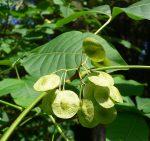 Also known as stinking ash and wafer ash, this deciduous small tree or large shrub is native to North and Central America where it grows in central and eastern US in open woods and prairies. The dark reddish brown branches have glands that produce an exude with a unique scent that is also given off by the flowers and bruised leaves. It is generally considered unpleasant although there are some people that find it agreeable. The compound shiny dark green leaves are oval to oblong and are three to five inches long by two to three inches wide. In late spring tiny greenish white flowers appear in terminal clusters and are followed in the fall by round pendulous winged seed pods one inch across, containing two seeds and persisting into mid winter. Hop-tree is drought tolerant and a good choice for a hedge, screen, or specimen especially in a xeriscape.
Also known as stinking ash and wafer ash, this deciduous small tree or large shrub is native to North and Central America where it grows in central and eastern US in open woods and prairies. The dark reddish brown branches have glands that produce an exude with a unique scent that is also given off by the flowers and bruised leaves. It is generally considered unpleasant although there are some people that find it agreeable. The compound shiny dark green leaves are oval to oblong and are three to five inches long by two to three inches wide. In late spring tiny greenish white flowers appear in terminal clusters and are followed in the fall by round pendulous winged seed pods one inch across, containing two seeds and persisting into mid winter. Hop-tree is drought tolerant and a good choice for a hedge, screen, or specimen especially in a xeriscape.
Type: Deciduous shrub or small tree
Height: 25′
Light: Full sun to partial shade
Hardiness: Zones 5-9
Photo Credit: Wikipedia
Scrub Oak (Quercus gambelii)
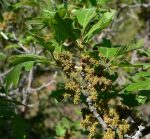 Also known as gambe oak, oak brush, and Rocky Mountain white oak, this deciduous small tree or large shrub is native to the foothills and lower mountain elevations in western North America including Arizona, New Mexico, Utah, Nevada, Wyoming, Idaho, Nebraska, Oklahoma panhandle, and western Texas. The trees usually grow 10-30′ tall but can reach 100′ or more where water is sufficient. They have furrowed or scaly, brownish-gray bark and 3-4.5″ long leaves that have 3-6 irregular lobes and are glossy dark green above, lighter and hairy beneath but may turn orange, yellow or red in the fall. In spring male and female catkins of inconspicuous flowers appear on the same tree. The female catkins form in the leaf axils and if fertilized give way to solitary or paired green acorns that are less than an inch long, age to brown, and are 1/4 to 1/2 enclosed in a cap. Scrub oak spreads by both acorns and specialized tubers that allow the tree to sprout even after fires. The tree is drought tolerant and a good choice for naturalistic areas and woodlands as well as in containers and as bonsai.
Also known as gambe oak, oak brush, and Rocky Mountain white oak, this deciduous small tree or large shrub is native to the foothills and lower mountain elevations in western North America including Arizona, New Mexico, Utah, Nevada, Wyoming, Idaho, Nebraska, Oklahoma panhandle, and western Texas. The trees usually grow 10-30′ tall but can reach 100′ or more where water is sufficient. They have furrowed or scaly, brownish-gray bark and 3-4.5″ long leaves that have 3-6 irregular lobes and are glossy dark green above, lighter and hairy beneath but may turn orange, yellow or red in the fall. In spring male and female catkins of inconspicuous flowers appear on the same tree. The female catkins form in the leaf axils and if fertilized give way to solitary or paired green acorns that are less than an inch long, age to brown, and are 1/4 to 1/2 enclosed in a cap. Scrub oak spreads by both acorns and specialized tubers that allow the tree to sprout even after fires. The tree is drought tolerant and a good choice for naturalistic areas and woodlands as well as in containers and as bonsai.
Type: Deciduous tree
Height: Up to 150′
Light: Full sun
Hardiness: Zones 4-7
Photo Credit:Wikimedia Commons
Creeping Rosemary (Rosmarinus officinalis ‘Prostratus’)
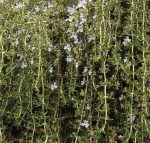 This low growing, spreading evergreen shrub is a cultivar of a plant native to the Mediterranean and a member of the mint family, Lamiaceae, that also includes beebalm, basal, and lavender. It grows 6-24″ tall and up to 4′ wide, rooting as it spreads. The needle-like leaves grayish green with whitish undersides and up to 2″ long. They have a pine-like scent and are valued as a culinary herb fresh or dried. From spring into summer, clusters of small pale blue to white tubular flowers appear that are attractive to both butterflies and bees. Creeping rosemary is valued for its use as a groundcover, in containers and window boxes, and in Mediterranean, wall, rock, herb, and xeric gardens.
This low growing, spreading evergreen shrub is a cultivar of a plant native to the Mediterranean and a member of the mint family, Lamiaceae, that also includes beebalm, basal, and lavender. It grows 6-24″ tall and up to 4′ wide, rooting as it spreads. The needle-like leaves grayish green with whitish undersides and up to 2″ long. They have a pine-like scent and are valued as a culinary herb fresh or dried. From spring into summer, clusters of small pale blue to white tubular flowers appear that are attractive to both butterflies and bees. Creeping rosemary is valued for its use as a groundcover, in containers and window boxes, and in Mediterranean, wall, rock, herb, and xeric gardens.
Type: Evergreen shrub
Height: 6-24″
Bloom Time: Spring into summer
Light: Full sun; tolerates some shade
Hardiness: Zones 8-10
Type:
Height:
Light:
Hardiness: Zones
Photo Credit:
Type:
Height:
Light:
Hardiness: Zones
Photo Credit: